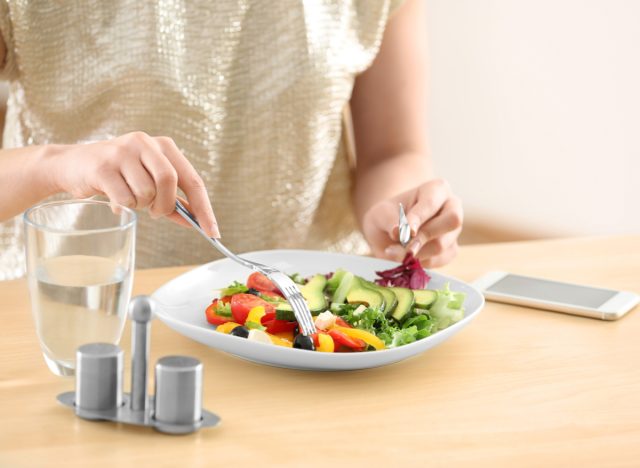Weight loss is possible through a multitude of different strategies—one of the most effective being adjustments to your diet. But it’s keeping that weight off once you lose it that’s especially challenging. In fact, a meta-analysis of 29 studies in The American Journal of Clinical Nutrition found that more than half of the weight lost by participants was regained within two years, and 80% was regained within five years. But don’t lose hope just yet: experts say it’s totally possible to maintain that fitter physique, as long as you adopt sustainable habits that you know you can stick to.
According to Nataly Georgieva, RD, a dietitian at JM Nutrition, fad diets often involve restrictive eating habits that simply aren’t realistic (or healthy) to keep up with over the long term.
“Such deprivation may result in feelings of ‘missing out’ on something, potential frustration and irritability, and eventual abandonment of the fad diet,” she explains. “As a result, you can regain the weight soon after.”
Not only that, but Samantha McKinney, RD, a dietitian at Life Time notes that a steep caloric deficit can shift hormones in an unfavorable direction. Basically, your body doesn’t know that the caloric deficit was intentional, so as a survival mechanism it’s primed to gain weight as soon as you go back to your normal eating habits.
There are no real shortcuts when it comes to weight loss, so experts say you’ll need to be patient with your body as you make changes to your diet. With that in mind, here are the best eating habits you can adopt to shed some pounds for good. Read on, and for more on how to eat healthy, don’t miss Eating Habits to Lose Abdominal Fat As You Age, Say Dietitians.


Weighing and measuring out every ingredient in your meals may help with portion control when you first start dieting, but the reality is that it’s too time-consuming to do forever. That’s why Kitty Broihier, MS, RD, a registered dietitian and creator of the Eating Habits Lab, advises visually portioning out the components of your meals using the MyPlate Guidelines instead.
Per these guidelines, which are devised by the United States Department of Agriculture, you should fill half your plate with vegetables and fruit, and the other half with a mix of 60% grains and about 40% protein (around 5 ½ ounces). Ideally, you should aim for a diverse mix of whole fruit and veggies, whole grains, and a variety of protein sources. Limit yourself to three cups worth of dairy, and try to stick with low-fat or fat-free options. Using these guidelines as you build your meals will ensure your body is getting all the satiating nutrients it needs.
Georgieva adds that it’s helpful to educate yourself on what recommended serving sizes look like, and to get comfortable reading nutrition facts labels.


If you’ve ever been hit with hunger pangs while at the office or in the car, you know how tempting it can be to grab a sugary energy bar from the vending machine or a salt-laden bag of chips at a nearby convenience store. But that’s why Georgieva recommends keeping healthy snacks on you at all times—in your desk drawer, lunch bag, office fridge, or glove box.
“Humans follow the path of least resistance,” says Georgieva. “It’s important to make nutritious foods easily accessible when you’re at your most vulnerable.”
Keep in mind that snacks with protein, fiber, and healthy fat will keep you full the longest. For example, an apple with string cheese, whole-grain crackers with turkey and hummus, or yogurt with flax seeds and blueberries are all satiating combos.
READ RELATED: Hanyu Yuzuru Olympics


Here’s an easy habit to try: start lunch and dinner by noshing on a fiber-rich salad and guzzling a glass of water. That way, you’re less likely to overindulge on the rest of your meal.
“This can help you eat fewer calories overall without leaving you hungry,” says Dana Ellis Hunnes, PhD, RD, a senior clinical dietitian at UCLA medical center and author of Recipe For Survival.
A 2008 study in the Journal of the American Dietetic Association found that obese older adults who drank two cups of water before breakfast consumed 13% fewer calories during their meal than those who didn’t drink water beforehand. Furthermore, a 2011 study in Obesity found that dieters who drank water before all three meals for 12 weeks lost about five pounds more than dieters who did not increase their water intake.
Dr. Hunnes recommends having a salad consisting of two cups of greens and a light vinaigrette with about one tablespoon of olive oil.


If there’s one macronutrient you should definitely be prioritizing for weight loss purposes, it’s protein.
“Protein can leave you feeling more full and satisfied than carbohydrates and fats,” says McKinney. “Often, the more protein you eat at meals, the fewer cravings you’ll experience. It’s the best-kept secret to losing weight without feeling deprived. Most of the time, those who ramp protein intake will inadvertently reduce their intake of starches, sugars, and mindless snacking. It also stabilizes blood sugar and energy levels, helps support detoxification, and is needed to recover from workouts.”
As a general rule, Broihier recommends aiming for about 20 grams at each meal and 10 grams at each snack. But if it helps to have a visual guideline to follow, McKinney says a palm-sized portion of protein is sufficient. For example, this can look like one chicken breast or salmon filet, two eggs, or a clenched fist’s worth of chickpeas.


One of the main causes of overeating is not being present during mealtimes. When you’re scrolling through your phone or watching TV, you may wolf down your food so fat that you don’t give your body a chance to register when it’s actually full.
That’s why Dr. Hunnes advises making it a point to practice mindful eating. This entails slowing down and really tuning in to all of your senses while eating a meal or snack. It’s also a good idea to try eliminating distractions while you eat, so you can more easily recognize your fullness cues.
“Pause for a minute or two halfway through to check in with your hunger level,” says Broihier. “People who practice this are often surprised to learn that they really do feel satisfied with less food than they thought. Lots of times we automatically and mindlessly finish what’s on our plates.”
Source:











